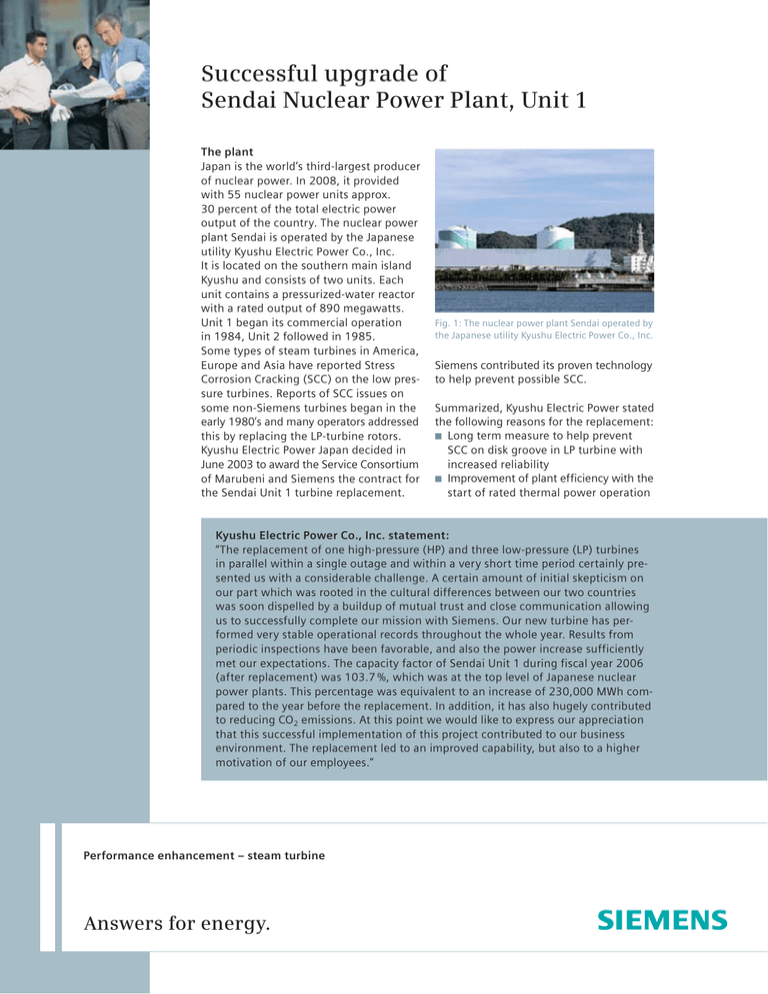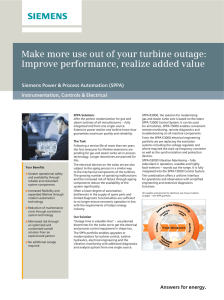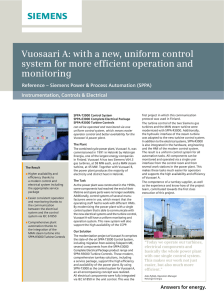
Successful upgrade of
Sendai Nuclear Power Plant, Unit 1
The plant
Japan is the world’s third-largest producer
of nuclear power. In 2008, it provided
with 55 nuclear power units approx.
30 percent of the total electric power
output of the country. The nuclear power
plant Sendai is operated by the Japanese
utility Kyushu Electric Power Co., Inc.
It is located on the southern main island
Kyushu and consists of two units. Each
unit contains a pressurized-water reactor
with a rated output of 890 megawatts.
Unit 1 began its commercial operation
in 1984, Unit 2 followed in 1985.
Some types of steam turbines in America,
Europe and Asia have reported Stress
Corrosion Cracking (SCC) on the low pressure turbines. Reports of SCC issues on
some non-Siemens turbines began in the
early 1980’s and many operators addressed
this by replacing the LP-turbine rotors.
Kyushu Electric Power Japan decided in
June 2003 to award the Service Consortium
of Marubeni and Siemens the contract for
the Sendai Unit 1 turbine replacement.
Fig. 1: The nuclear power plant Sendai operated by
the Japanese utility Kyushu Electric Power Co., Inc.
Siemens contributed its proven technology
to help prevent possible SCC.
Summarized, Kyushu Electric Power stated
the following reasons for the replacement:
■ Long term measure to help prevent
SCC on disk groove in LP turbine with
increased reliability
■ Improvement of plant efficiency with the
start of rated thermal power operation
Kyushu Electric Power Co., Inc. statement:
“The replacement of one high-pressure (HP) and three low-pressure (LP) turbines
in parallel within a single outage and within a very short time period certainly presented us with a considerable challenge. A certain amount of initial skepticism on
our part which was rooted in the cultural differences between our two countries
was soon dispelled by a buildup of mutual trust and close communication allowing
us to successfully complete our mission with Siemens. Our new turbine has performed very stable operational records throughout the whole year. Results from
periodic inspections have been favorable, and also the power increase sufficiently
met our expectations. The capacity factor of Sendai Unit 1 during fiscal year 2006
(after replacement) was 103.7 %, which was at the top level of Japanese nuclear
power plants. This percentage was equivalent to an increase of 230,000 MWh compared to the year before the replacement. In addition, it has also hugely contributed
to reducing CO2 emissions. At this point we would like to express our appreciation
that this successful implementation of this project contributed to our business
environment. The replacement led to an improved capability, but also to a higher
motivation of our employees.”
Performance enhancement – steam turbine
Answers for energy.
Upgrading the turbines with state-of-theart technology products can provide a
reliable long-term solution, which can
pay itself back through increased performance. This can result in potential high
turbine reliability, efficiency and also in
increased electrical output.
Scope of supply
As part of the modernization of the conventional island of Sendai Unit 1, Siemens
modernized one HP turbine as well as three
LP turbines consisting of rotors and inner
casings including jack shafts. The outer
casings of the formerly-installed turbines
were not replaced but were reused. Planning, manufacturing, providing data for
licensing support and supervision of the
installation were also part of the scope
of supply from Siemens.
The consortium leader Marubeni was
responsible for commercial aspects,
installation work on site, and translation
of each document and drawing. The
customer-own assembly group Nishinippon
Plant Engineering and Construction Co.,
Ltd. (NPC) was subcontracted by Marubeni
for the installation. Siemens provided
supervision.
The execution of the project was very
successful. The implementation of the
upgrade was performed in March 2006
within 58 days as scheduled and guaranteed. The measured vibration level was
much lower than the level guaranteed by
Siemens. In particular the modern blade
technology of Siemens and some other
features helped make this possible.
HP Turbine –
Siemens steam turbine design
The HP turbine was modernized with
state-of-the-art technology. It includes
our advanced three-dimensional design
blades with reduced secondary flow
losses and a full-arc admission. This was
installed by reusing the outer casing.
The three-dimensional design of the
Published by and copyright © 2010:
Siemens AG
Energy Sector
Freyeslebenstrasse 1
91058 Erlangen, Germany
Siemens Energy, Inc.
4400 Alafaya Trail
Orlando, FL 32826-2399, USA
www.siemens.com/energy
Fig. 2: Advanced three-dimensional design
blades with reduced secondary flow losses
Fig. 3: Advanced disk rotor
blades developed by Siemens provides
a flexible solution offering a wide range
of applications. The design is also intended
to minimize profile, secondary and tip
losses in the turbine blade stage. This
can result in significant improvements
in blade efficiency (up to 2 % as compared
to conventional blade designs).
Design methods and performance
features
Siemens design methods and performance
features are intended to provide a stateof-the-art fully three-dimensional design
by means of advanced computational
methods such as computer-aided design,
constant fraction discriminator and finite
element method. These features have
helped obtain world-class efficiencies
over a wide range of volumetric flows
as well as increasing overall power output.
The installation of the new design features
and the modern blade technology is expected to result in the following benefits
for our customer:
■ Power increase
■ Higher erosion and corrosion
resistance
■ Easy disassembly
LP Turbine –
Siemens steam turbine design
The integration of a single shell inner
casing, an advanced disk rotor, six-disk
design as well as larger last-stage blades
results in an efficient and highly reliable
turbine design.
Since the upgrade was completed and
the unit returned to operation, the results
of the modernization have shown:
■ higher reliability
■ efficiency increase
■ reduced exhaust losses
■ higher SCC resistance
■ easier assembly and disassembly.
For more information, please contact
our Customer Support Center.
Phone: +49 180/524 70 00
Fax:
+49 180/524 24 71
(Charges depending on provider)
E-mail: support.energy@siemens.com
References
Siemens has worldwide experience in
steam turbine modernizations and has
modernized more than 50 comparable nuclear units. The nuclear power plant Sendai
Unit 1 turbine modernization was realized
on schedule. The new turbine has operated
with a low level of vibration (less than
50 µm peak – peak) and performance testing indicated that the limited output warranty was exceeded. This technology is
also applicable for fossil solutions and can
thus also be used for other applications.
For more information please contact
your local Siemens sales representative.
Energy Service Division
Order No. E50001-G520-A178-X-4A00
Printed in Germany
Dispo 34805, c4bs No. 7816, 7822
TH 258-090539 460322 DB 03102.0
Printed on elementary chlorine-free
bleached paper.
All rights reserved.
Trademarks mentioned in this document
are the property of Siemens AG, its affiliates,
or their respective owners.
Subject to change without prior notice.
The information in this document contains
general descriptions of the technical options
available, which may not apply in all cases.
The required technical options should therefore
be specified in the contract.


